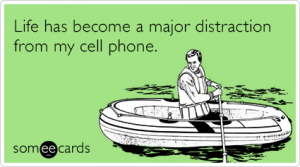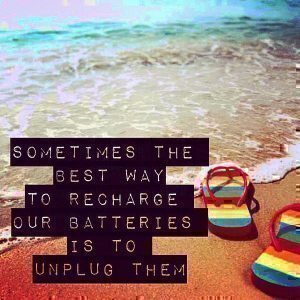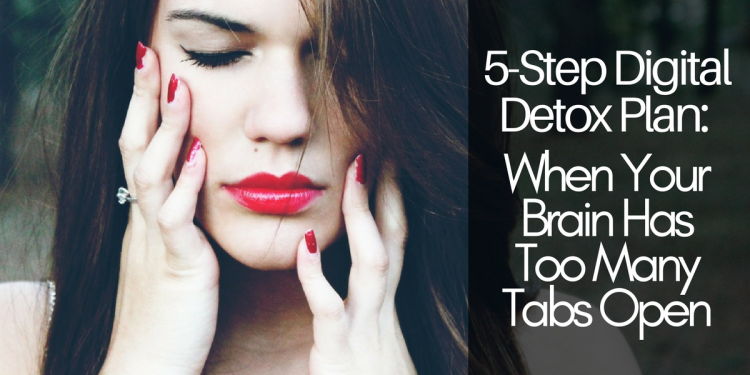Recently I wrote about my personal struggle to balance technology use in my life. I realized that my smartphone, especially social media, often interrupts my ability to live in the moment and be present. However, I also totally recognize that I have a dependence on technology for some key activities in my life, even more so as a military spouse. And so my love-hate relationship with technology continues.

Technology isn’t going anywhere, and unless we plan to live off-the-grid in a doomsday bunker, we have to learn to live with it – on our terms. So after some reflection, I drafted a Digital Detox Plan for myself, and share it with you in hopes that some of these actions can also help you reclaim your mind and attention.
In reading the action plan, you will see that some of my suggestions still include technology and apps. I do see the irony that I’m suggesting technology to cut-back on technology, but going cold-turkey and just cutting everything out won’t work. Take baby-steps and try to tackle these one at a time!

P.S. If this action plan works, please make sure you take time to post to everyone on social media about how you’re not going to use social media now. PSYCH! TOTALLY KIDDING! That would defeat the purpose!
1. Uninstall apps from your phone.
I’ve decided to uninstall all non-essential apps from my phone. While I’ve spent the most time talking about Facebook, for me non-vital also includes Instagram, Twitter and even some news apps. Uninstalling them reduces access to social media, etc. I have to put in the effort of either searching for it on my phone browser, or going on my laptop to see it.
If I do go on Facebook or Instagram on my phone browser, I make sure to log out every time and not have my password saved so that I actually have to have to put in the password if I want to access again. Being prompted for the password upon login gives me a moment to question whether I really need to log in or not.

2. Set up private “shared” iPhoto groups.
Apple allows you to set up shared photo groups and limit the access to the family and friends that you actually care about. Many of us only go on Facebook to see what a small handful of people we love are doing, but then get sucked in to our newsfeed by all the other clutter and people we don’t even really know that well (remember that girl from the fourth grade?)
Setting up a private group lets you share photos with those people, and notifies you when others in the group upload new photos. That way, you don’t have to go to Facebook to see them. This also works really well with my loved ones who have babies, so that they don’t have to put intimate family pics on social media, but a close circle can still see them. If you don’t have an iPhone, there are apps out there that achieve the same purpose.
3. Designate a specific amount of time for social media.
As mentioned, we sometimes get sucked into social media, and what was intended to be a two-minute check quickly turns into a two-hour time suck. Decide a specific time and duration that you will allow yourself to look at social media every day or week, and then only look during those times. Remember, nothing that important is going to change between the times that you log in, and if something really important actually happens, someone will call or text you! Once you decide what that amount of time should be, set a timer to avoid your life flashing before your eyes.

4. Put your phones away.
Put phones in a drawer when you get home from work, and during times that you should truly be present. Making the phone less accessible and out of sight curtails your desire to check it and subsequently peruse the internet. For example, when you’re having dinner with friends or a spouse, sitting on the couch watching TV or maybe even when you’re a passenger in the car. It makes me sad to think all the beautiful vistas I’ve probably missed on road trips because I was too busy on my phone as my husband drove us there!
Remember, if something is a true emergency someone will call, so if it makes you feel better to keep the ringer sound on while it’s put away, feel free to do so.
5. Track your technology use.
Why do some people lose more weight when they have to track every little thing they put in their mouths? Because it makes them more aware of their eating behaviors, and helps them rationalize whether they need that candy or not. The same applies to tracking your technology use.
Before starting your action plan, spend some time reflecting on one complete day, and think of all the times you accessed your smartphone or other technology platform.
- What did you look at, and how many times?
- Why did you look?
- Where and what time did you look at it?
- Did you gain anything tangible from looking at it?
- How did you feel after looking?
- How many times total did you look at each app?
Reflecting on your answers allows you to understand your technology or smartphone triggers, be more cognizant, and think of ways to avoid or resist the temptation. You might find that the answer to “why” is usually boredom.
In doing this reflection, I found that I always looked on Instagram when I was standing in line at the grocery checkout. Once I realized this, I was able to develop a routine where instead of looking at my smartphone, I observed the other shoppers around me, or even chatted with some of them. I know that observing others might sound boring or silly, but there are some interesting things to see when you don’t have your eyes glued to a screen!

Subscribe to Millspouse: This Week








